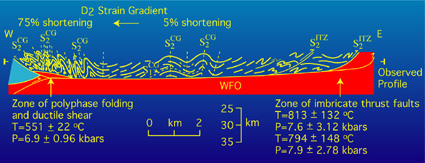Publications
° Daczko, N.R.,
Klepeis, K.A. and Clarke, G.L. 2002. Thermo-mechanical evolution of the crust during convergence
and deep crustal pluton emplacement in the western province of Fiordland,
New Zealand. Tectonics, 21(4), 1022, doi:
10.1029/ 2001TC001282.
Abstract
Fiordland, New Zealand, contains exposures of high-pressure (P = 12–14 kbar)
granulite facies rocks that form one of Earth’s largest exposed lower crustal
roots of an Early Cretaceous magmatic arc. These exposures allowed us to examine
the mechanisms and processes that controlled crustal thickening and large
vertical displacements at the deepest levels of a deforming arc system. We
present structural and metamorphic data that show how the root of this arc
was tectonically thickened by imbricate, granulite facies thrust zones during
and after the emplacement of sheeted plutons into the middle and lower crust.
The imbricate thrust zones form part of a wellexposed, 12 km wide, two-sided
fold-thrust belt that preferentially developed in crust that was thermally
softened by magmatism. Changes in metamorphic mineral assemblages and microstructural
data from the contact aureole of a composite arc batholith called the Western
Fiordland Orthogneiss record thrust and pluton emplacement conditions of
P = 7–9 kbar (paleodepths of 25–30 km). These data show that thrust imbrication
and tectonic loading at 30 km depth is a viable mechanism of large vertical
displacements and crustal thickening at the deepest levels of magmatic arcs.
This mechanism produced a characteristic up-pressure metamorphic history
that is similar to that observed in many other large magmatic belts worldwide.

|
 ARC Centre of Excellence for Core to Crust Fluid Systems
ARC Centre of Excellence for Core to Crust Fluid Systems